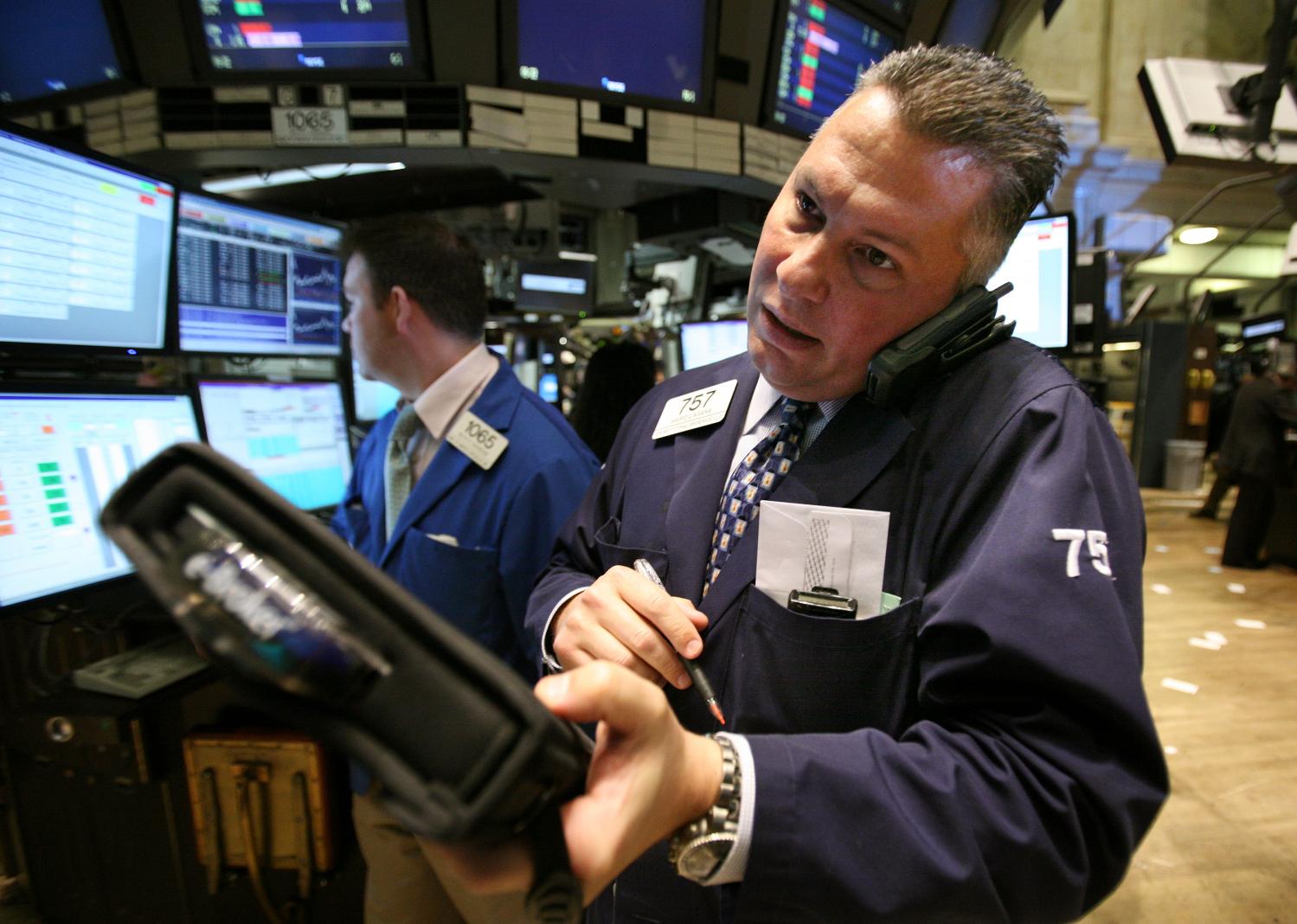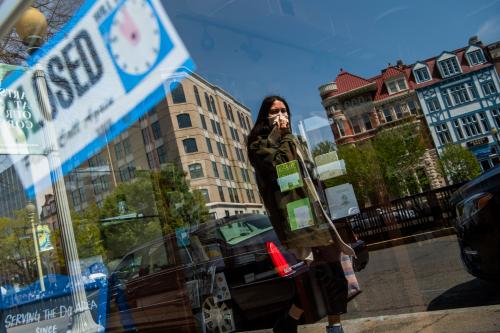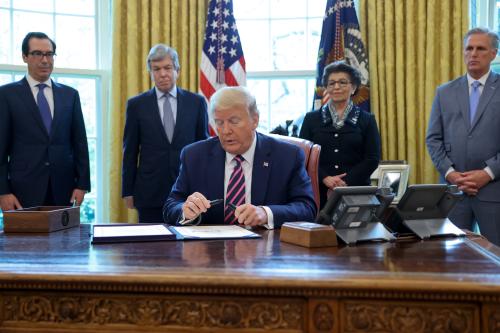This report is part of the Series on Financial Markets and Regulation and was produced by the Brookings Center on Regulation and Markets.
Rarely does Congress act with near unanimity, but just this week it passed legislation changing the Paycheck Protection Program (PPP) to give businesses more flexibility to use up to $660 billion of taxpayer funds. Originally marketed as a loan to small businesses to keep workers on payroll during a brief pandemic-induced shutdown, the PPP has become a grant program giving billions to small, medium, and large businesses to pay for much more than just workers’ paychecks. This new law further shifts the program from helping workers survive the crisis to helping businesses stay afloat. The result will be that more workers at small businesses fall through the cracks of this hastily designed safety net.
New Law Goes Down the Wrong Road
From inception, the PPP was a grant disguised as a loan. Designed to flow through the Small Business Administration’s (SBA) existing loan program, banks and lenders became gatekeepers of the funds. Businesses were always in the know: more than half expected PPP to be a full grant, and only 2 percent thought they’d ever have to repay even half of what they were given.
At first, the law stated that loans would be forgiven (become a grant) as long as the business used 75 percent of their for payroll over eight weeks. The new law eases this requirement on many fronts, including lowering the threshold to 60 percent and extending the payroll period through December 31. Hence any small business that keeps enough payroll for the rest of 2020 to meet 60 percent of the PPP it received should be able to keep it all.
True, the new law adapts to the reality that much of America is likely to remain in some type of shutdown for months, not weeks. The surprising good news that 2.5 million jobs were added back to the economy in May is a small dent. Eight out of 9 jobs lost since the pandemic began have not come back.
Changing PPP gives businesses more time to delay rehiring workers, resulting in fewer paychecks for workers. Further, the new law increases the share of PPP funds that can go for paying things like rent, reducing the share that goes to workers. Lowering the threshold required to pay workers by 15 percent shifts $76.5 billion from paying employees to potentially paying bills. Instead of protecting workers’ paychecks, this money is protecting businesses that owe money to other businesses. Larger businesses that are creditors to businesses that got PPP funding are the winners of this shift.
Rather than protecting workers and paychecks, the PPP is moving toward protecting businesses. As my Brookings colleague Joshua Gotbaum has written, an alternative approach to using banks and lenders to reach businesses with pseudo-loans is to instead use the IRS to reach payrolls (or even workers) directly. Representative Jayapal (D-WA), Stevens (D-MI), and others have introduced legislation to achieve that goal, using a process similar to how Germany, South Korea, and others have helped workers during this crisis.
Almost 59 million Americans work at a small businesses. Had the $510 billion PPP program has given to businesses instead gone directly to workers, every worker at every small business would have received over $8,650. For the PPP program to make sense, it has to be more efficient in helping workers at small businesses survive this pandemic than direct support. For those workers who are not fortunate enough to be rehired, enhanced unemployment benefits are set to expire in less than two months. It is hard to imagine Congress acting as quickly or unanimously to help the unemployed by extending UI benefits as it just did to allow businesses to use PPP grants to pay expenses not workers.
Got the Size Right
The problem is how the program was structured, not the amount of money thrown at the problem. In fact, there’s plenty of PPP money left over. The first come, first serve scramble surrounding PPP’s launch has given way to extra money waiting for applicants. After the original $350 billion appropriated by Congress in the CARES Act was gobbled up in less than 14 days, many wondered if the $310 billion Congress added would satisfy the significant, unmet demand. In fact, only about two-thirds of the new money has been used, and applications for new PPP funds have slowed substantially. More than $120 billion of PPP money remains and little new money being requested over the past few weeks, evidence that the Treasury Department properly forecasted total demand for PPP funds.
Decline in demand is not a function of the problems in the financial pipeline that plagued PPP during its launch. Over 90 percent of small businesses surveyed were planning to apply for funds have already received them. Given the ample additional money that remains and that not all businesses that are interested will be eligible, the second round funding for PPP was correct. Congress and the Treasury deserve praise for the difficult job of predicting demand for a new program during these uncertain times.
Congress’s decision to alter the rules of the program may stimulate additional demand, avoiding a $120 billion pot of money sitting unused during a pandemic. But the new legislation reduces pressure on businesses receiving the money to use it to pay their workers during the shutdown or rehire them quickly as reopening commences. The result will be fewer dollars ending up in the pockets of workers and more grants from Uncle Sam going from one business to another.
Second Round of PPP Targets More Small Businesses, but Big Guys Still Get A Lot
First the good news: big businesses got less money in the second round. The number of million dollar plus grants/loans in the second round shrank substantially. Out of over 2.8 million businesses funded in round two only 15,158 received seven figures or more. Yet these bigger companies gobbled up over $28 billion of the second round of PPP funding. Put another way, only 1 out of 200 loans were for $1 million or more, but 1 out of every 6 dollars of PPP round two was given to those bigger businesses. That is an improvement over the first round when the million dollar plus loans took 44.5 percent of all funds despite being only 4 percent of total loans.
Over its short life, the PPP program has spent over $180 billion, or 35 percent of its funds, supporting businesses asking for $1 million or more. Less than half of the program, 3 out of every 7 dollars (42 percent) has gone to what most would consider small businesses, those asking for under $350,000. The really small businesses, who asked for $100k or less, received just 20 percent of total PPP funds, despite constituting 80 percent of the businesses funded.

A Better Way Forward
It will take months if not years to see how many small business workers ended up getting paid as a result of PPP and how many slipped through the growing cracks of this program. Rather than hastily trying to force hundreds of billions of dollars through banks and lending programs, the federal government could have paid workers directly through the tax system. Plenty of problems exist in that method as well – millions are still waiting for their Covid stimulus check to arrive – but it would have at least allowed Congress to focus on workers or truly small businesses.
To improve our response to pandemics and other crises in the future, the government needs to fundamentally change its payment system. Instead of relying on banks as intermediaries, Uncle Sam should develop the capability to directly fund businesses and workers when the need arises. Policy makers should not disguise grants as loans nor have to work through multiple intermediaries (banks, businesses, etc.) to reach workers. Congress should focus on building our financial resiliency as part of our pandemic response plan rather than loosening requirements that focus on saving businesses, not people.
The Brookings Institution is committed to quality, independence, and impact.
We are supported by a diverse array of funders. In line with our values and policies, each Brookings publication represents the sole views of its author(s).






Commentary
Op-edLosing sight of workers in protecting paychecks
June 5, 2020